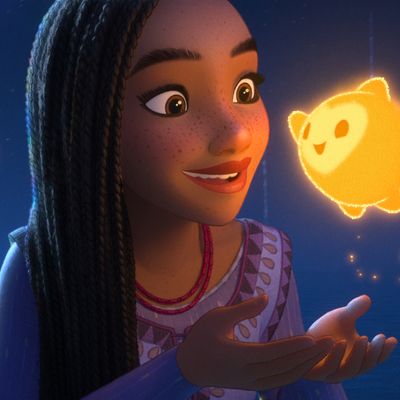
Any Disney animated film could have been called Wish at some point. That’s presumably the idea behind the title of the studio’s latest, which has been positioned as a tribute to the company’s 100 years in the business. Wish is itself a new Disney fairy tale, but it has been consciously structured like all the other classic Disney fairy tales. Only it’s, you know, new — familiar yet different, filled with so-called Easter eggs but hopefully compelling in its own right.
It’s a promising, challenging idea with the competing poles of reverence and self-awareness built into the film’s very reason for existence. Unfortunately, Wish manages to be none of the things it wants to be. It is neither evocative enough of the past to work as a tribute, nor irreverent or inventive or just plain funny enough to justify its constant but half-hearted callouts. It’s the ultimate cop-out — a lifeless, uninspiring mess of bland brand management.
The problem is evident from the get-go as a storybook introduction tells us about the origin of the kingdom of Rosas, which was founded by “a young man who believed there was nothing more important than a wish” because a wish “drives your heart” and “makes you who you are.” After realizing how devastating it is to have your wishes crushed, he founded an island kingdom in the Mediterranean where everyone was welcome and called himself Magnifico. There, at the age of 18, every citizen would give him their wish for safekeeping, whereupon they would proceed to forget what their wish ever was. Then, every month, he would grant one person’s wish.
This is an odd, unconvincing setup bearing the inchoate trappings of a classic fable but with an immediate and profound phoniness. Yes, King Magnifico (voiced by Chris Pine) will soon be revealed as more of a mad tyrant than a benevolent monarch, but even veiled dystopias demand some sort of base logic. This one, however, prompts a million questions: Why would anybody think this is a good thing? Who on earth willingly gives away their wishes and then willingly forgets about them? Why do these people have only one wish in the first place? If your wish is so important to you, wouldn’t you just proceed to have it again after you gave it away? Oh, that’s not how it works in this corner of the world? Well, then, how does it work, exactly? What are their wishes, anyway? Has anybody involved in the making of Wish had an actual wish ever? Wait, is this meant to be a scathing metaphor for capitalism? From DISNEY?
There’s nothing wrong with nonsense in animation — these are fantasies, after all, so nonsense is kind of the point — but while it’s decidedly unrealistic in both spirit and matter, the world of Rosas is also never weird or fanciful enough to support the kind of tall tale that could run on its own silliness. We just twiddle our thumbs waiting for this mealymouthed premise to be unraveled as the silly fraud that it is.
So it’s not long before our clumsily earnest heroine, Asha (voiced by Ariana DeBose), discovers Magnifico’s more sinister side when she asks him to grant her 100-year-old grandfather’s wish, which was to create something to inspire the next generation. (Really? He wished this when he was 18? Okay, enough with the questions.) Magnifico deems this wish too dangerous, thus revealing himself to be the raging, snarling despot that he is. But here’s the thing: The wishes in Wish, on the rare occasion that they’re actually expressed, are so vague and tepid that one assumes any evil wizard worth his salt could probably grant them while simultaneously defanging them, thereby keeping his evil magic wizard island kingdom safe from rebellion or whatever. But that would of course threaten to make the villain more interesting.
The visual style of Wish, we’ve been told, represents a bold experiment, mixing three-dimensional and two-dimensional animation as a way to pay tribute to Disney’s hand-drawn past and hyperdigital present. The backgrounds do have a watercolor softness — though they don’t quite have the texture of watercolors, which makes them look more like an imitation than the real thing. Still, such hybrids have worked splendidly in other hands: The 2019 Netflix film Klaus (a movie that is weird enough to support its imaginatively silly story) blends a marvelously expressionistic hand-drawn style with three-dimensional lighting effects, and the Spider-Verse films have dazzled millions with their delirious, purposeful patchwork animation.
In Wish, however, the opposing forces cancel each other out: The 3-D makes the 2-D look automated and fake, while the 2-D jars uncomfortably with the 3-D such that the characters’ rounded, glowing digital faces sometimes float unmoored inside more traditional designs. At times, it reminded me of Clutch Cargo, the late ’50s lo-fi cult TV series that superimposed video footage of human mouths against hand-drawn characters, once memorably glimpsed in Pulp Fiction. All that expense to look so cheap.
This probably wasn’t the intention. Wish is clearly beholden to Disney’s groundbreaking 1959 classic Sleeping Beauty, a fever dream of twisted perspectives and angular figures influenced by illuminated manuscripts and medieval tapestries. But in the same way that Wish isn’t irreverent enough to be so self-referential, it doesn’t have the courage to look so boldly designed; it’s as if Sleeping Beauty were robbed of all the things that have made it interesting, distinctive, even controversial at times. There isn’t a facial gesture or a character movement here that doesn’t look like something you’ve seen dozens of times already. It all feels rote, predictable, programmed.
Still, it might have worked, at least a little, if the songs weren’t so dull. Not unlike Frozen, the music of Wish does have a Broadway-ready feel — particularly one climactic piece whose performance already seems designed for the stage, not the screen — but there’s a hollowness and predictability to the tunes and lyrics. Again, it feels like a series of imitations, at times combining the rat-tat-tat wordplay of Lin-Manuel Miranda (Encanto, Moana) and the show-tune-y self-awareness of Robert and Kristen Lopez (Frozen) but with none of their actual charm or spark. The music in Wish seems to have been conceived and written not to advance the story or provide beauty but to fill an industrial need. (There is one exception, “Knowing What I Know Now,” a rollicking, drum-drenched anthem performed by Asha and her friends against multicolored dancing shadow puppets of Magnifico that gives us a glimpse of the far more visually and sonically exciting movie Wish could have been.)
Wish was directed by Chris Buck and Fawn Veerasunthorn and written by Jennifer Lee and Allison Moore, some of whom are veterans of Frozen and have put in enough time at Disney to suggest that the problems with this film weren’t fundamentally creative but corporate. These big-budget animated releases take so long to make their way to the screen with countless man-hours spent on every detail. One suspects that Wish, as the company’s big anniversary project, was so fussed over by the powers that be that anything original or inventive about it was story-noted and sweatboxed out of existence along the way. That’s the generous reading. Because otherwise we might have to conclude that Disney has simply run out of ideas — and that’s a notion too apocalyptic to contemplate.
More Movie Reviews
- Anyone But You Has More Sex on Its Mind Than Your Average Rom-Com
- An Exploited Neighborhood, Seen Through Children’s Eyes
- Challengers Is Almost a Sexy Movie





